There should be a strict government regulation of the Vaping industry Topic 2022
VerifiedAdded on 2022/09/12
|13
|3737
|25
AI Summary
Contribute Materials
Your contribution can guide someone’s learning journey. Share your
documents today.
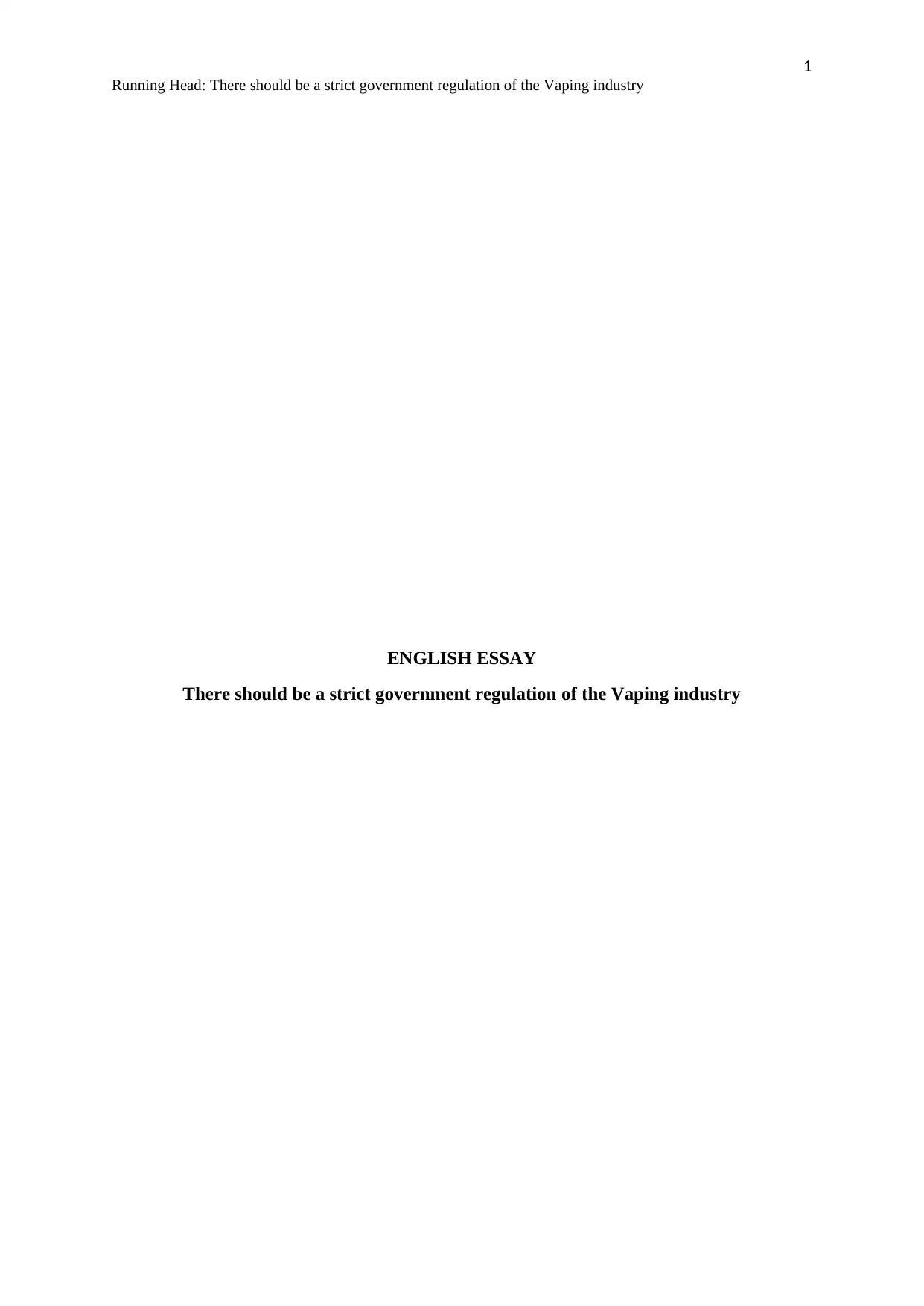
1
Running Head: There should be a strict government regulation of the Vaping industry
ENGLISH ESSAY
There should be a strict government regulation of the Vaping industry
Running Head: There should be a strict government regulation of the Vaping industry
ENGLISH ESSAY
There should be a strict government regulation of the Vaping industry
Secure Best Marks with AI Grader
Need help grading? Try our AI Grader for instant feedback on your assignments.

2
There should be a strict government regulation of the Vaping industry
Table of Contents
Introduction................................................................................................................................3
Growth of Vaping Industry and Government Benefits..............................................................3
Impact on Youngsters................................................................................................................6
Measures to be taken by Government........................................................................................7
Conclusion..................................................................................................................................9
References................................................................................................................................10
There should be a strict government regulation of the Vaping industry
Table of Contents
Introduction................................................................................................................................3
Growth of Vaping Industry and Government Benefits..............................................................3
Impact on Youngsters................................................................................................................6
Measures to be taken by Government........................................................................................7
Conclusion..................................................................................................................................9
References................................................................................................................................10

3
There should be a strict government regulation of the Vaping industry
Introduction
According to Borodovsky, et. al. (2016), the enhanced amount of smoking recently has
started a new trend of electronic cigarettes. These have been quite a contemporary trend
globally and can also be referred to as e-cigarette. As opined by Dawkins, Turner, Roberts
and Soar (2013), the E-cigarettes are electronic device which simulates smoking of tobacco.
They use incombustible tobacco products and are operated with the help of batteries which
helps in heating up of liquid and delivering aerosolized product to the individual. As stated by
Walley, Wilson, Winickoff and Groner (2019), e-cigarette or in general term known as
vaping has been facing a lot of challenges as they have been posing harm for the public. The
main aim of the paper is to justify the reason for the government posing strict regulation in
the vaping industry. The topic was chosen in the context on my husband choosing vaping as
an option with an intent to quit smoking. Instead, of helping him to quit and live a smoke-free
life, it became a more frequent alternative of smoking. Therefore, the audience that are
selected for the research are my contemporaries and the source used for the research was
MPTC library. The paper primarily focuses on the growth of the vaping industry in recent
times and the support it receives from the government. The paper will also be highlighting the
influence of e-cigarettes on the youngsters and measures that needs to be taken by the
government for reducing its prevalence in the lives of the people.
Growth of Vaping Industry and Government Benefits
According to Gostin and Glasner (2014), vaping products are said to be a revolutionary and
innovative way that helps people to quit smoking. Traditional tobacco smoking which are
combustible and the users tends to breathe in smoke from the burning tobacco. Whereas in e-
cigarette or vaping users inhale the vapor that is created from a substance known as e-liquid.
In contrast to tobacco cigarettes all the electronic vaping devices constitute of nicotine. As
opined by Wilson, Winickoff and Groner (2019), nicotine is the tobacco-derived compound
There should be a strict government regulation of the Vaping industry
Introduction
According to Borodovsky, et. al. (2016), the enhanced amount of smoking recently has
started a new trend of electronic cigarettes. These have been quite a contemporary trend
globally and can also be referred to as e-cigarette. As opined by Dawkins, Turner, Roberts
and Soar (2013), the E-cigarettes are electronic device which simulates smoking of tobacco.
They use incombustible tobacco products and are operated with the help of batteries which
helps in heating up of liquid and delivering aerosolized product to the individual. As stated by
Walley, Wilson, Winickoff and Groner (2019), e-cigarette or in general term known as
vaping has been facing a lot of challenges as they have been posing harm for the public. The
main aim of the paper is to justify the reason for the government posing strict regulation in
the vaping industry. The topic was chosen in the context on my husband choosing vaping as
an option with an intent to quit smoking. Instead, of helping him to quit and live a smoke-free
life, it became a more frequent alternative of smoking. Therefore, the audience that are
selected for the research are my contemporaries and the source used for the research was
MPTC library. The paper primarily focuses on the growth of the vaping industry in recent
times and the support it receives from the government. The paper will also be highlighting the
influence of e-cigarettes on the youngsters and measures that needs to be taken by the
government for reducing its prevalence in the lives of the people.
Growth of Vaping Industry and Government Benefits
According to Gostin and Glasner (2014), vaping products are said to be a revolutionary and
innovative way that helps people to quit smoking. Traditional tobacco smoking which are
combustible and the users tends to breathe in smoke from the burning tobacco. Whereas in e-
cigarette or vaping users inhale the vapor that is created from a substance known as e-liquid.
In contrast to tobacco cigarettes all the electronic vaping devices constitute of nicotine. As
opined by Wilson, Winickoff and Groner (2019), nicotine is the tobacco-derived compound
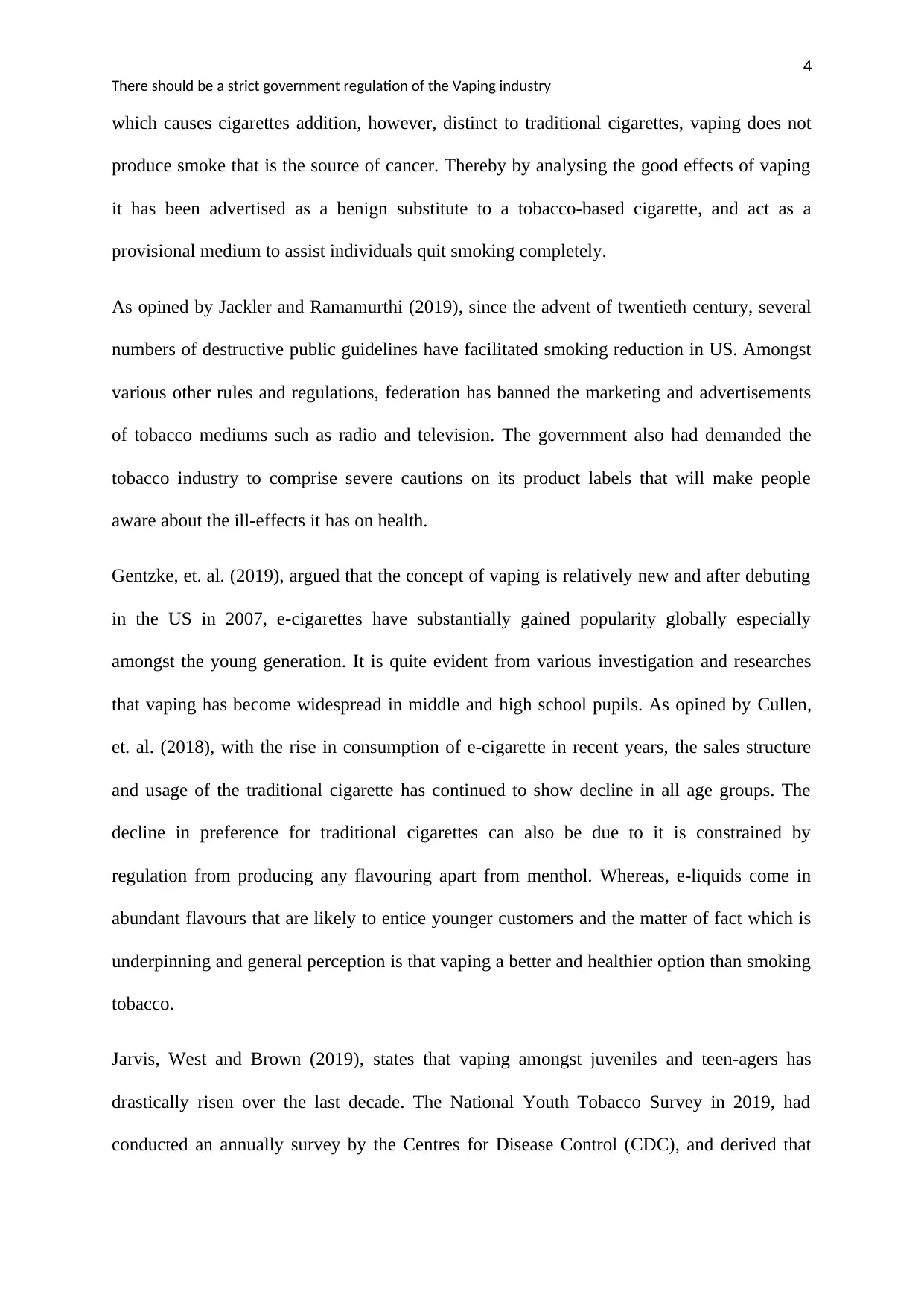
4
There should be a strict government regulation of the Vaping industry
which causes cigarettes addition, however, distinct to traditional cigarettes, vaping does not
produce smoke that is the source of cancer. Thereby by analysing the good effects of vaping
it has been advertised as a benign substitute to a tobacco-based cigarette, and act as a
provisional medium to assist individuals quit smoking completely.
As opined by Jackler and Ramamurthi (2019), since the advent of twentieth century, several
numbers of destructive public guidelines have facilitated smoking reduction in US. Amongst
various other rules and regulations, federation has banned the marketing and advertisements
of tobacco mediums such as radio and television. The government also had demanded the
tobacco industry to comprise severe cautions on its product labels that will make people
aware about the ill-effects it has on health.
Gentzke, et. al. (2019), argued that the concept of vaping is relatively new and after debuting
in the US in 2007, e-cigarettes have substantially gained popularity globally especially
amongst the young generation. It is quite evident from various investigation and researches
that vaping has become widespread in middle and high school pupils. As opined by Cullen,
et. al. (2018), with the rise in consumption of e-cigarette in recent years, the sales structure
and usage of the traditional cigarette has continued to show decline in all age groups. The
decline in preference for traditional cigarettes can also be due to it is constrained by
regulation from producing any flavouring apart from menthol. Whereas, e-liquids come in
abundant flavours that are likely to entice younger customers and the matter of fact which is
underpinning and general perception is that vaping a better and healthier option than smoking
tobacco.
Jarvis, West and Brown (2019), states that vaping amongst juveniles and teen-agers has
drastically risen over the last decade. The National Youth Tobacco Survey in 2019, had
conducted an annually survey by the Centres for Disease Control (CDC), and derived that
There should be a strict government regulation of the Vaping industry
which causes cigarettes addition, however, distinct to traditional cigarettes, vaping does not
produce smoke that is the source of cancer. Thereby by analysing the good effects of vaping
it has been advertised as a benign substitute to a tobacco-based cigarette, and act as a
provisional medium to assist individuals quit smoking completely.
As opined by Jackler and Ramamurthi (2019), since the advent of twentieth century, several
numbers of destructive public guidelines have facilitated smoking reduction in US. Amongst
various other rules and regulations, federation has banned the marketing and advertisements
of tobacco mediums such as radio and television. The government also had demanded the
tobacco industry to comprise severe cautions on its product labels that will make people
aware about the ill-effects it has on health.
Gentzke, et. al. (2019), argued that the concept of vaping is relatively new and after debuting
in the US in 2007, e-cigarettes have substantially gained popularity globally especially
amongst the young generation. It is quite evident from various investigation and researches
that vaping has become widespread in middle and high school pupils. As opined by Cullen,
et. al. (2018), with the rise in consumption of e-cigarette in recent years, the sales structure
and usage of the traditional cigarette has continued to show decline in all age groups. The
decline in preference for traditional cigarettes can also be due to it is constrained by
regulation from producing any flavouring apart from menthol. Whereas, e-liquids come in
abundant flavours that are likely to entice younger customers and the matter of fact which is
underpinning and general perception is that vaping a better and healthier option than smoking
tobacco.
Jarvis, West and Brown (2019), states that vaping amongst juveniles and teen-agers has
drastically risen over the last decade. The National Youth Tobacco Survey in 2019, had
conducted an annually survey by the Centres for Disease Control (CDC), and derived that
Secure Best Marks with AI Grader
Need help grading? Try our AI Grader for instant feedback on your assignments.
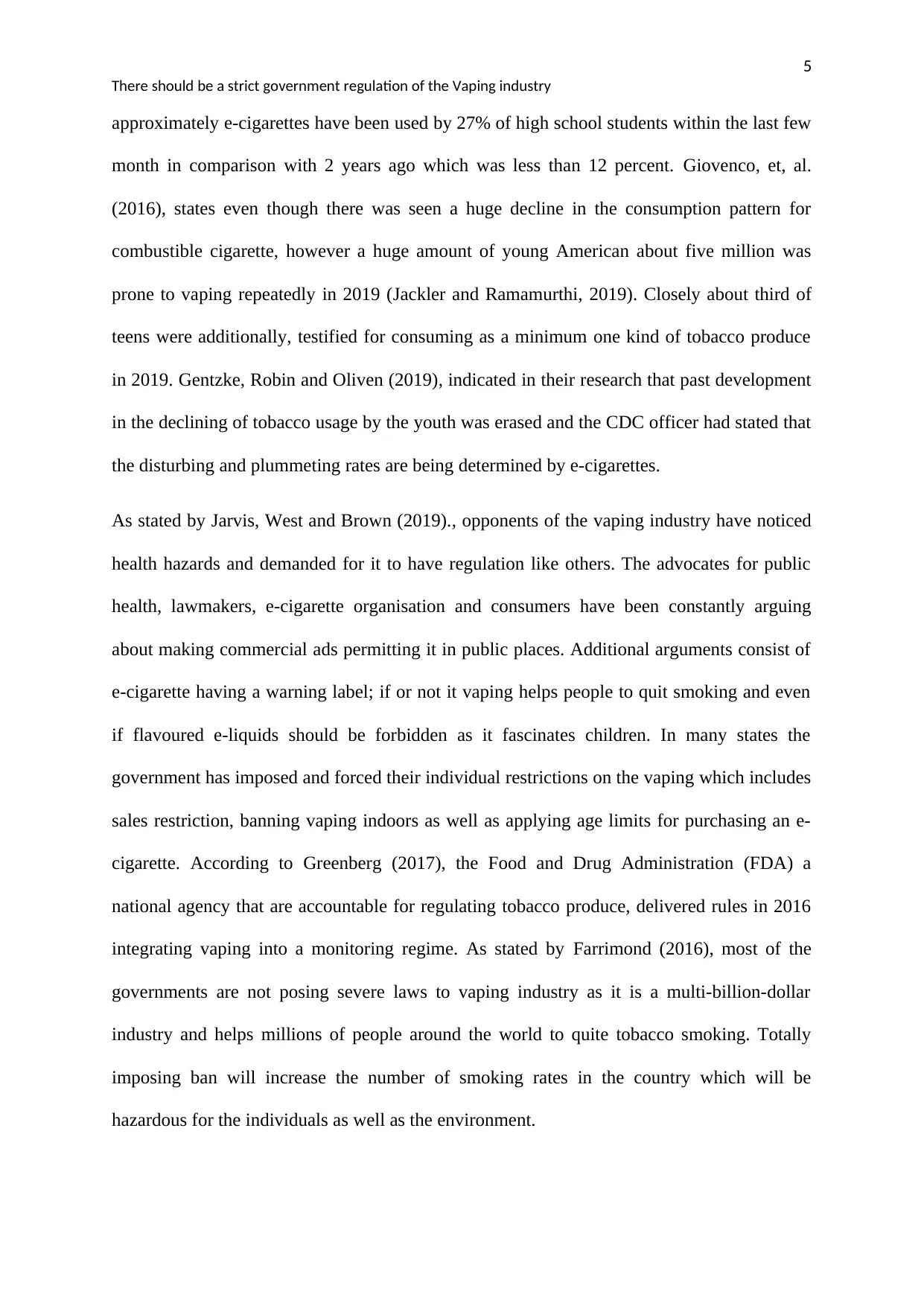
5
There should be a strict government regulation of the Vaping industry
approximately e-cigarettes have been used by 27% of high school students within the last few
month in comparison with 2 years ago which was less than 12 percent. Giovenco, et, al.
(2016), states even though there was seen a huge decline in the consumption pattern for
combustible cigarette, however a huge amount of young American about five million was
prone to vaping repeatedly in 2019 (Jackler and Ramamurthi, 2019). Closely about third of
teens were additionally, testified for consuming as a minimum one kind of tobacco produce
in 2019. Gentzke, Robin and Oliven (2019), indicated in their research that past development
in the declining of tobacco usage by the youth was erased and the CDC officer had stated that
the disturbing and plummeting rates are being determined by e-cigarettes.
As stated by Jarvis, West and Brown (2019)., opponents of the vaping industry have noticed
health hazards and demanded for it to have regulation like others. The advocates for public
health, lawmakers, e-cigarette organisation and consumers have been constantly arguing
about making commercial ads permitting it in public places. Additional arguments consist of
e-cigarette having a warning label; if or not it vaping helps people to quit smoking and even
if flavoured e-liquids should be forbidden as it fascinates children. In many states the
government has imposed and forced their individual restrictions on the vaping which includes
sales restriction, banning vaping indoors as well as applying age limits for purchasing an e-
cigarette. According to Greenberg (2017), the Food and Drug Administration (FDA) a
national agency that are accountable for regulating tobacco produce, delivered rules in 2016
integrating vaping into a monitoring regime. As stated by Farrimond (2016), most of the
governments are not posing severe laws to vaping industry as it is a multi-billion-dollar
industry and helps millions of people around the world to quite tobacco smoking. Totally
imposing ban will increase the number of smoking rates in the country which will be
hazardous for the individuals as well as the environment.
There should be a strict government regulation of the Vaping industry
approximately e-cigarettes have been used by 27% of high school students within the last few
month in comparison with 2 years ago which was less than 12 percent. Giovenco, et, al.
(2016), states even though there was seen a huge decline in the consumption pattern for
combustible cigarette, however a huge amount of young American about five million was
prone to vaping repeatedly in 2019 (Jackler and Ramamurthi, 2019). Closely about third of
teens were additionally, testified for consuming as a minimum one kind of tobacco produce
in 2019. Gentzke, Robin and Oliven (2019), indicated in their research that past development
in the declining of tobacco usage by the youth was erased and the CDC officer had stated that
the disturbing and plummeting rates are being determined by e-cigarettes.
As stated by Jarvis, West and Brown (2019)., opponents of the vaping industry have noticed
health hazards and demanded for it to have regulation like others. The advocates for public
health, lawmakers, e-cigarette organisation and consumers have been constantly arguing
about making commercial ads permitting it in public places. Additional arguments consist of
e-cigarette having a warning label; if or not it vaping helps people to quit smoking and even
if flavoured e-liquids should be forbidden as it fascinates children. In many states the
government has imposed and forced their individual restrictions on the vaping which includes
sales restriction, banning vaping indoors as well as applying age limits for purchasing an e-
cigarette. According to Greenberg (2017), the Food and Drug Administration (FDA) a
national agency that are accountable for regulating tobacco produce, delivered rules in 2016
integrating vaping into a monitoring regime. As stated by Farrimond (2016), most of the
governments are not posing severe laws to vaping industry as it is a multi-billion-dollar
industry and helps millions of people around the world to quite tobacco smoking. Totally
imposing ban will increase the number of smoking rates in the country which will be
hazardous for the individuals as well as the environment.

6
There should be a strict government regulation of the Vaping industry
Impact on Youngsters
Through various studies it has been noted that nicotine use by youth is adversely affecting the
brain development of the youngsters. This view has been agreed by Berlin et al. (2019), as he
stated that the increased use of nicotine is harmful for development of brain and it also
impacts the physical development. About more than one in four high school students and
about one in fourteen middle school students as marked in 2018, used tobacco product in the
past 30 days. The invention of e-cigarettes has increased the number of smokers or tobacco
users from 11.7% to 20.08% among the high school students from 2017 to 2018. E-cigarette
is the new way of consuming tobacco which has been increasing the number of tobacco
consumers and the impact on health is much more critical than the traditional ones. It is stated
by Liberman et al. (2018), that one JUUL e cigarette is equivalent to a pack of cigarette
which reveals the increase in consumption of nicotine among youngsters.
World Health Organisation states the short term health consequences of in taking nicotine
includes respiratory and non-respiratory effects. The addiction of nicotine and other tobacco
consumptions impacts the respiratory system of the youngsters which gradually transforms
into other physical health issues. The rate of growth of lungs gets impacted highly along with
the development of brain. In teenage, the intake of nicotine reduces the development of brain
and the capability of exploring new things and inventing capacity reduces (Royal et al. 2018).
Additional to respiratory and brain development, smoking impacts the functioning of hearts
in a proper and adequate manner. Heart disease and strokes have been observed to be the
early signs of intaking nicotine in early age. Studies have revealed that someone who smokes
a pack or more cigarettes everyday lives 7 years less than the ones who never smoked. As per
Pentel et al. (2018), the resting heart rate of those youngsters who smoke are two to three
beats per minute faster than the non-smokers. The increasing number of adult smokers needs
to be controlled by the government as in the view of Teitelbaum et al. (2018), who suggests
There should be a strict government regulation of the Vaping industry
Impact on Youngsters
Through various studies it has been noted that nicotine use by youth is adversely affecting the
brain development of the youngsters. This view has been agreed by Berlin et al. (2019), as he
stated that the increased use of nicotine is harmful for development of brain and it also
impacts the physical development. About more than one in four high school students and
about one in fourteen middle school students as marked in 2018, used tobacco product in the
past 30 days. The invention of e-cigarettes has increased the number of smokers or tobacco
users from 11.7% to 20.08% among the high school students from 2017 to 2018. E-cigarette
is the new way of consuming tobacco which has been increasing the number of tobacco
consumers and the impact on health is much more critical than the traditional ones. It is stated
by Liberman et al. (2018), that one JUUL e cigarette is equivalent to a pack of cigarette
which reveals the increase in consumption of nicotine among youngsters.
World Health Organisation states the short term health consequences of in taking nicotine
includes respiratory and non-respiratory effects. The addiction of nicotine and other tobacco
consumptions impacts the respiratory system of the youngsters which gradually transforms
into other physical health issues. The rate of growth of lungs gets impacted highly along with
the development of brain. In teenage, the intake of nicotine reduces the development of brain
and the capability of exploring new things and inventing capacity reduces (Royal et al. 2018).
Additional to respiratory and brain development, smoking impacts the functioning of hearts
in a proper and adequate manner. Heart disease and strokes have been observed to be the
early signs of intaking nicotine in early age. Studies have revealed that someone who smokes
a pack or more cigarettes everyday lives 7 years less than the ones who never smoked. As per
Pentel et al. (2018), the resting heart rate of those youngsters who smoke are two to three
beats per minute faster than the non-smokers. The increasing number of adult smokers needs
to be controlled by the government as in the view of Teitelbaum et al. (2018), who suggests
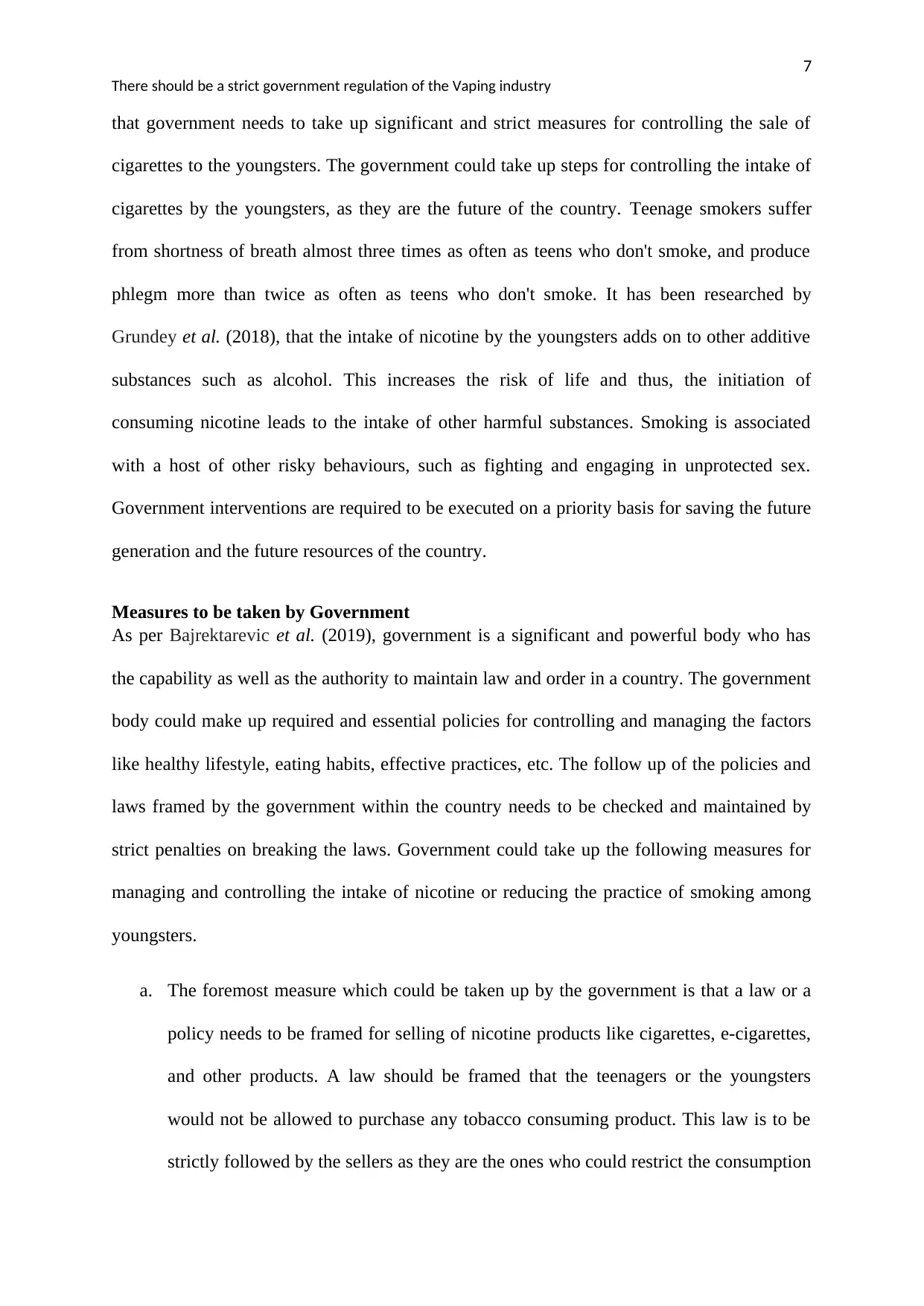
7
There should be a strict government regulation of the Vaping industry
that government needs to take up significant and strict measures for controlling the sale of
cigarettes to the youngsters. The government could take up steps for controlling the intake of
cigarettes by the youngsters, as they are the future of the country. Teenage smokers suffer
from shortness of breath almost three times as often as teens who don't smoke, and produce
phlegm more than twice as often as teens who don't smoke. It has been researched by
Grundey et al. (2018), that the intake of nicotine by the youngsters adds on to other additive
substances such as alcohol. This increases the risk of life and thus, the initiation of
consuming nicotine leads to the intake of other harmful substances. Smoking is associated
with a host of other risky behaviours, such as fighting and engaging in unprotected sex.
Government interventions are required to be executed on a priority basis for saving the future
generation and the future resources of the country.
Measures to be taken by Government
As per Bajrektarevic et al. (2019), government is a significant and powerful body who has
the capability as well as the authority to maintain law and order in a country. The government
body could make up required and essential policies for controlling and managing the factors
like healthy lifestyle, eating habits, effective practices, etc. The follow up of the policies and
laws framed by the government within the country needs to be checked and maintained by
strict penalties on breaking the laws. Government could take up the following measures for
managing and controlling the intake of nicotine or reducing the practice of smoking among
youngsters.
a. The foremost measure which could be taken up by the government is that a law or a
policy needs to be framed for selling of nicotine products like cigarettes, e-cigarettes,
and other products. A law should be framed that the teenagers or the youngsters
would not be allowed to purchase any tobacco consuming product. This law is to be
strictly followed by the sellers as they are the ones who could restrict the consumption
There should be a strict government regulation of the Vaping industry
that government needs to take up significant and strict measures for controlling the sale of
cigarettes to the youngsters. The government could take up steps for controlling the intake of
cigarettes by the youngsters, as they are the future of the country. Teenage smokers suffer
from shortness of breath almost three times as often as teens who don't smoke, and produce
phlegm more than twice as often as teens who don't smoke. It has been researched by
Grundey et al. (2018), that the intake of nicotine by the youngsters adds on to other additive
substances such as alcohol. This increases the risk of life and thus, the initiation of
consuming nicotine leads to the intake of other harmful substances. Smoking is associated
with a host of other risky behaviours, such as fighting and engaging in unprotected sex.
Government interventions are required to be executed on a priority basis for saving the future
generation and the future resources of the country.
Measures to be taken by Government
As per Bajrektarevic et al. (2019), government is a significant and powerful body who has
the capability as well as the authority to maintain law and order in a country. The government
body could make up required and essential policies for controlling and managing the factors
like healthy lifestyle, eating habits, effective practices, etc. The follow up of the policies and
laws framed by the government within the country needs to be checked and maintained by
strict penalties on breaking the laws. Government could take up the following measures for
managing and controlling the intake of nicotine or reducing the practice of smoking among
youngsters.
a. The foremost measure which could be taken up by the government is that a law or a
policy needs to be framed for selling of nicotine products like cigarettes, e-cigarettes,
and other products. A law should be framed that the teenagers or the youngsters
would not be allowed to purchase any tobacco consuming product. This law is to be
strictly followed by the sellers as they are the ones who could restrict the consumption
Paraphrase This Document
Need a fresh take? Get an instant paraphrase of this document with our AI Paraphraser
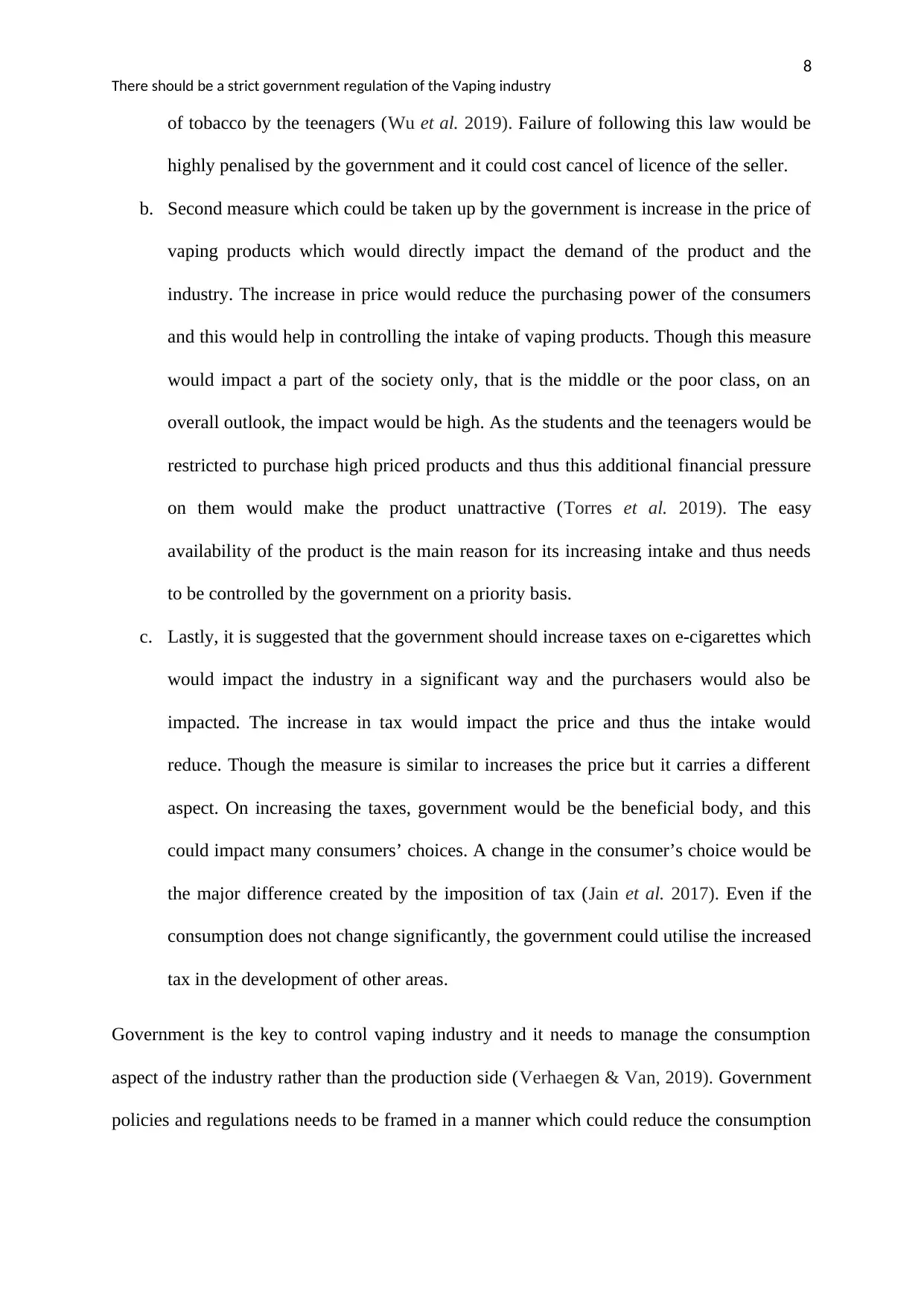
8
There should be a strict government regulation of the Vaping industry
of tobacco by the teenagers (Wu et al. 2019). Failure of following this law would be
highly penalised by the government and it could cost cancel of licence of the seller.
b. Second measure which could be taken up by the government is increase in the price of
vaping products which would directly impact the demand of the product and the
industry. The increase in price would reduce the purchasing power of the consumers
and this would help in controlling the intake of vaping products. Though this measure
would impact a part of the society only, that is the middle or the poor class, on an
overall outlook, the impact would be high. As the students and the teenagers would be
restricted to purchase high priced products and thus this additional financial pressure
on them would make the product unattractive (Torres et al. 2019). The easy
availability of the product is the main reason for its increasing intake and thus needs
to be controlled by the government on a priority basis.
c. Lastly, it is suggested that the government should increase taxes on e-cigarettes which
would impact the industry in a significant way and the purchasers would also be
impacted. The increase in tax would impact the price and thus the intake would
reduce. Though the measure is similar to increases the price but it carries a different
aspect. On increasing the taxes, government would be the beneficial body, and this
could impact many consumers’ choices. A change in the consumer’s choice would be
the major difference created by the imposition of tax (Jain et al. 2017). Even if the
consumption does not change significantly, the government could utilise the increased
tax in the development of other areas.
Government is the key to control vaping industry and it needs to manage the consumption
aspect of the industry rather than the production side (Verhaegen & Van, 2019). Government
policies and regulations needs to be framed in a manner which could reduce the consumption
There should be a strict government regulation of the Vaping industry
of tobacco by the teenagers (Wu et al. 2019). Failure of following this law would be
highly penalised by the government and it could cost cancel of licence of the seller.
b. Second measure which could be taken up by the government is increase in the price of
vaping products which would directly impact the demand of the product and the
industry. The increase in price would reduce the purchasing power of the consumers
and this would help in controlling the intake of vaping products. Though this measure
would impact a part of the society only, that is the middle or the poor class, on an
overall outlook, the impact would be high. As the students and the teenagers would be
restricted to purchase high priced products and thus this additional financial pressure
on them would make the product unattractive (Torres et al. 2019). The easy
availability of the product is the main reason for its increasing intake and thus needs
to be controlled by the government on a priority basis.
c. Lastly, it is suggested that the government should increase taxes on e-cigarettes which
would impact the industry in a significant way and the purchasers would also be
impacted. The increase in tax would impact the price and thus the intake would
reduce. Though the measure is similar to increases the price but it carries a different
aspect. On increasing the taxes, government would be the beneficial body, and this
could impact many consumers’ choices. A change in the consumer’s choice would be
the major difference created by the imposition of tax (Jain et al. 2017). Even if the
consumption does not change significantly, the government could utilise the increased
tax in the development of other areas.
Government is the key to control vaping industry and it needs to manage the consumption
aspect of the industry rather than the production side (Verhaegen & Van, 2019). Government
policies and regulations needs to be framed in a manner which could reduce the consumption
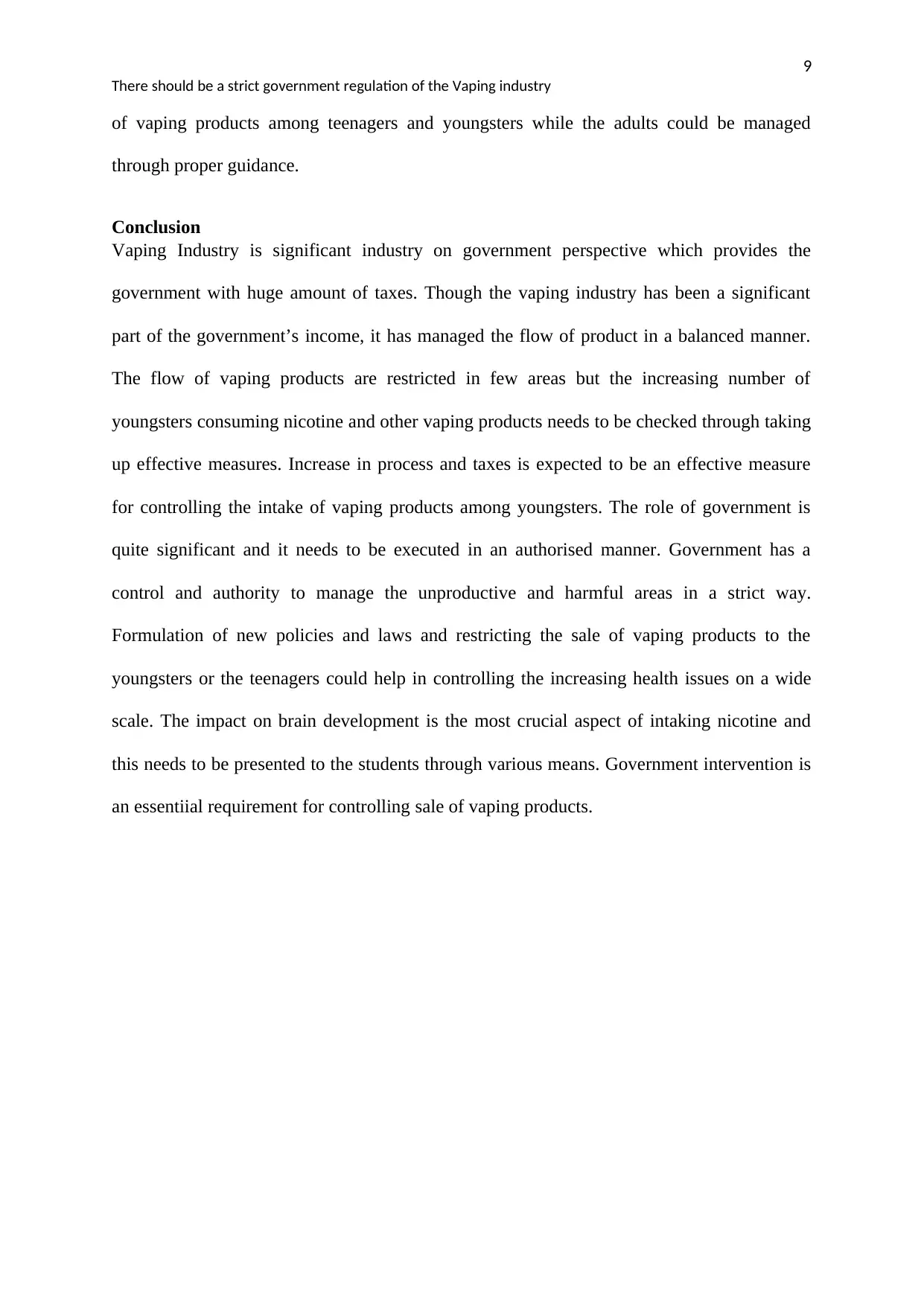
9
There should be a strict government regulation of the Vaping industry
of vaping products among teenagers and youngsters while the adults could be managed
through proper guidance.
Conclusion
Vaping Industry is significant industry on government perspective which provides the
government with huge amount of taxes. Though the vaping industry has been a significant
part of the government’s income, it has managed the flow of product in a balanced manner.
The flow of vaping products are restricted in few areas but the increasing number of
youngsters consuming nicotine and other vaping products needs to be checked through taking
up effective measures. Increase in process and taxes is expected to be an effective measure
for controlling the intake of vaping products among youngsters. The role of government is
quite significant and it needs to be executed in an authorised manner. Government has a
control and authority to manage the unproductive and harmful areas in a strict way.
Formulation of new policies and laws and restricting the sale of vaping products to the
youngsters or the teenagers could help in controlling the increasing health issues on a wide
scale. The impact on brain development is the most crucial aspect of intaking nicotine and
this needs to be presented to the students through various means. Government intervention is
an essentiial requirement for controlling sale of vaping products.
There should be a strict government regulation of the Vaping industry
of vaping products among teenagers and youngsters while the adults could be managed
through proper guidance.
Conclusion
Vaping Industry is significant industry on government perspective which provides the
government with huge amount of taxes. Though the vaping industry has been a significant
part of the government’s income, it has managed the flow of product in a balanced manner.
The flow of vaping products are restricted in few areas but the increasing number of
youngsters consuming nicotine and other vaping products needs to be checked through taking
up effective measures. Increase in process and taxes is expected to be an effective measure
for controlling the intake of vaping products among youngsters. The role of government is
quite significant and it needs to be executed in an authorised manner. Government has a
control and authority to manage the unproductive and harmful areas in a strict way.
Formulation of new policies and laws and restricting the sale of vaping products to the
youngsters or the teenagers could help in controlling the increasing health issues on a wide
scale. The impact on brain development is the most crucial aspect of intaking nicotine and
this needs to be presented to the students through various means. Government intervention is
an essentiial requirement for controlling sale of vaping products.
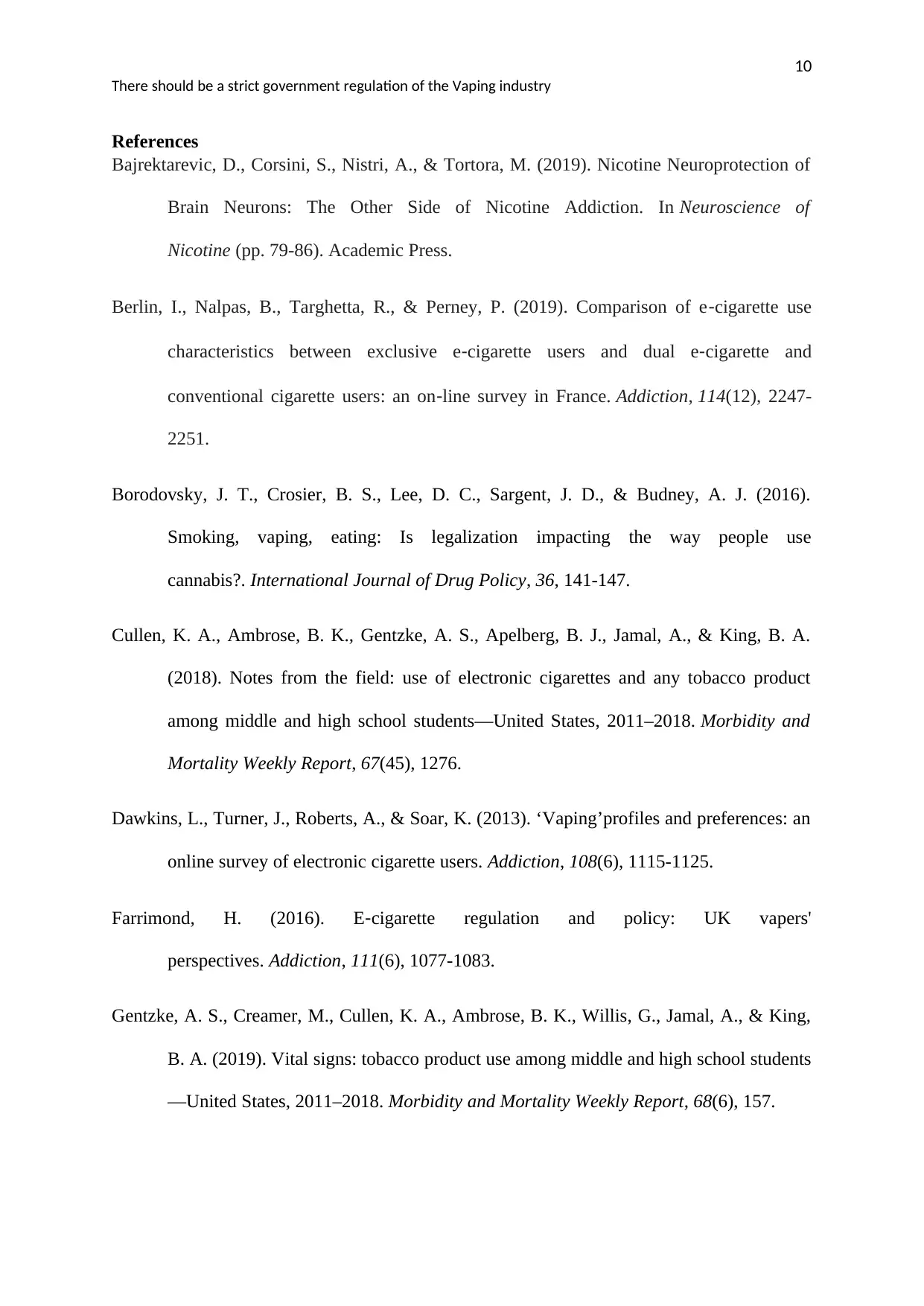
10
There should be a strict government regulation of the Vaping industry
References
Bajrektarevic, D., Corsini, S., Nistri, A., & Tortora, M. (2019). Nicotine Neuroprotection of
Brain Neurons: The Other Side of Nicotine Addiction. In Neuroscience of
Nicotine (pp. 79-86). Academic Press.
Berlin, I., Nalpas, B., Targhetta, R., & Perney, P. (2019). Comparison of e‐cigarette use
characteristics between exclusive e‐cigarette users and dual e‐cigarette and
conventional cigarette users: an on‐line survey in France. Addiction, 114(12), 2247-
2251.
Borodovsky, J. T., Crosier, B. S., Lee, D. C., Sargent, J. D., & Budney, A. J. (2016).
Smoking, vaping, eating: Is legalization impacting the way people use
cannabis?. International Journal of Drug Policy, 36, 141-147.
Cullen, K. A., Ambrose, B. K., Gentzke, A. S., Apelberg, B. J., Jamal, A., & King, B. A.
(2018). Notes from the field: use of electronic cigarettes and any tobacco product
among middle and high school students—United States, 2011–2018. Morbidity and
Mortality Weekly Report, 67(45), 1276.
Dawkins, L., Turner, J., Roberts, A., & Soar, K. (2013). ‘Vaping’profiles and preferences: an
online survey of electronic cigarette users. Addiction, 108(6), 1115-1125.
Farrimond, H. (2016). E‐cigarette regulation and policy: UK vapers'
perspectives. Addiction, 111(6), 1077-1083.
Gentzke, A. S., Creamer, M., Cullen, K. A., Ambrose, B. K., Willis, G., Jamal, A., & King,
B. A. (2019). Vital signs: tobacco product use among middle and high school students
—United States, 2011–2018. Morbidity and Mortality Weekly Report, 68(6), 157.
There should be a strict government regulation of the Vaping industry
References
Bajrektarevic, D., Corsini, S., Nistri, A., & Tortora, M. (2019). Nicotine Neuroprotection of
Brain Neurons: The Other Side of Nicotine Addiction. In Neuroscience of
Nicotine (pp. 79-86). Academic Press.
Berlin, I., Nalpas, B., Targhetta, R., & Perney, P. (2019). Comparison of e‐cigarette use
characteristics between exclusive e‐cigarette users and dual e‐cigarette and
conventional cigarette users: an on‐line survey in France. Addiction, 114(12), 2247-
2251.
Borodovsky, J. T., Crosier, B. S., Lee, D. C., Sargent, J. D., & Budney, A. J. (2016).
Smoking, vaping, eating: Is legalization impacting the way people use
cannabis?. International Journal of Drug Policy, 36, 141-147.
Cullen, K. A., Ambrose, B. K., Gentzke, A. S., Apelberg, B. J., Jamal, A., & King, B. A.
(2018). Notes from the field: use of electronic cigarettes and any tobacco product
among middle and high school students—United States, 2011–2018. Morbidity and
Mortality Weekly Report, 67(45), 1276.
Dawkins, L., Turner, J., Roberts, A., & Soar, K. (2013). ‘Vaping’profiles and preferences: an
online survey of electronic cigarette users. Addiction, 108(6), 1115-1125.
Farrimond, H. (2016). E‐cigarette regulation and policy: UK vapers'
perspectives. Addiction, 111(6), 1077-1083.
Gentzke, A. S., Creamer, M., Cullen, K. A., Ambrose, B. K., Willis, G., Jamal, A., & King,
B. A. (2019). Vital signs: tobacco product use among middle and high school students
—United States, 2011–2018. Morbidity and Mortality Weekly Report, 68(6), 157.
Secure Best Marks with AI Grader
Need help grading? Try our AI Grader for instant feedback on your assignments.

11
There should be a strict government regulation of the Vaping industry
Gentzke, A. S., Robin, K., & Oliven, L. (2019). Surge in youth tobacco product use: causes
and public health implications.
Giovenco, D. P., Casseus, M., Duncan, D. T., Coups, E. J., Lewis, M. J., & Delnevo, C. D.
(2016). Association between electronic cigarette marketing near schools and e-
cigarette use among youth. Journal of Adolescent Health, 59(6), 627-634.
Gostin, L. O., & Glasner, A. Y. (2014). E-cigarettes, vaping, and youth. Jama, 312(6), 595-
596.
Greenberg, L. H. (2017). The Deeming Rule: The FDA's Destruction of the Vaping
Industry. Brook. L. Rev., 83, 777.
Grundey, J., Barlay, J., Batsikadze, G., Kuo, M. F., Paulus, W., & Nitsche, M. (2018).
Nicotine modulates human brain plasticity via calcium‐dependent mechanisms. The
Journal of physiology, 596(22), 5429-5441.
Grundey, J., Barlay, J., Batsikadze, G., Kuo, M. F., Paulus, W., & Nitsche, M. (2018).
Nicotine modulates human brain plasticity via calcium‐dependent mechanisms. The
Journal of physiology, 596(22), 5429-5441.
Jackler, R. K., & Ramamurthi, D. (2019). Nicotine arms race: JUUL and the high-nicotine
product market. Tobacco control, 28(6), 623-628.
Jain, J. J., Bankar, V. B., & Bawankar, R. D. (2017). NICOTINE CHEWING GUM
REMEDIAL APPROACH AGAINST SMOKING AND CHEWING
HABITS. Journal of Medical Pharmaceutical and Allied Sciences (Vol-
6_I9_2017), 3, 848-858.
There should be a strict government regulation of the Vaping industry
Gentzke, A. S., Robin, K., & Oliven, L. (2019). Surge in youth tobacco product use: causes
and public health implications.
Giovenco, D. P., Casseus, M., Duncan, D. T., Coups, E. J., Lewis, M. J., & Delnevo, C. D.
(2016). Association between electronic cigarette marketing near schools and e-
cigarette use among youth. Journal of Adolescent Health, 59(6), 627-634.
Gostin, L. O., & Glasner, A. Y. (2014). E-cigarettes, vaping, and youth. Jama, 312(6), 595-
596.
Greenberg, L. H. (2017). The Deeming Rule: The FDA's Destruction of the Vaping
Industry. Brook. L. Rev., 83, 777.
Grundey, J., Barlay, J., Batsikadze, G., Kuo, M. F., Paulus, W., & Nitsche, M. (2018).
Nicotine modulates human brain plasticity via calcium‐dependent mechanisms. The
Journal of physiology, 596(22), 5429-5441.
Grundey, J., Barlay, J., Batsikadze, G., Kuo, M. F., Paulus, W., & Nitsche, M. (2018).
Nicotine modulates human brain plasticity via calcium‐dependent mechanisms. The
Journal of physiology, 596(22), 5429-5441.
Jackler, R. K., & Ramamurthi, D. (2019). Nicotine arms race: JUUL and the high-nicotine
product market. Tobacco control, 28(6), 623-628.
Jain, J. J., Bankar, V. B., & Bawankar, R. D. (2017). NICOTINE CHEWING GUM
REMEDIAL APPROACH AGAINST SMOKING AND CHEWING
HABITS. Journal of Medical Pharmaceutical and Allied Sciences (Vol-
6_I9_2017), 3, 848-858.
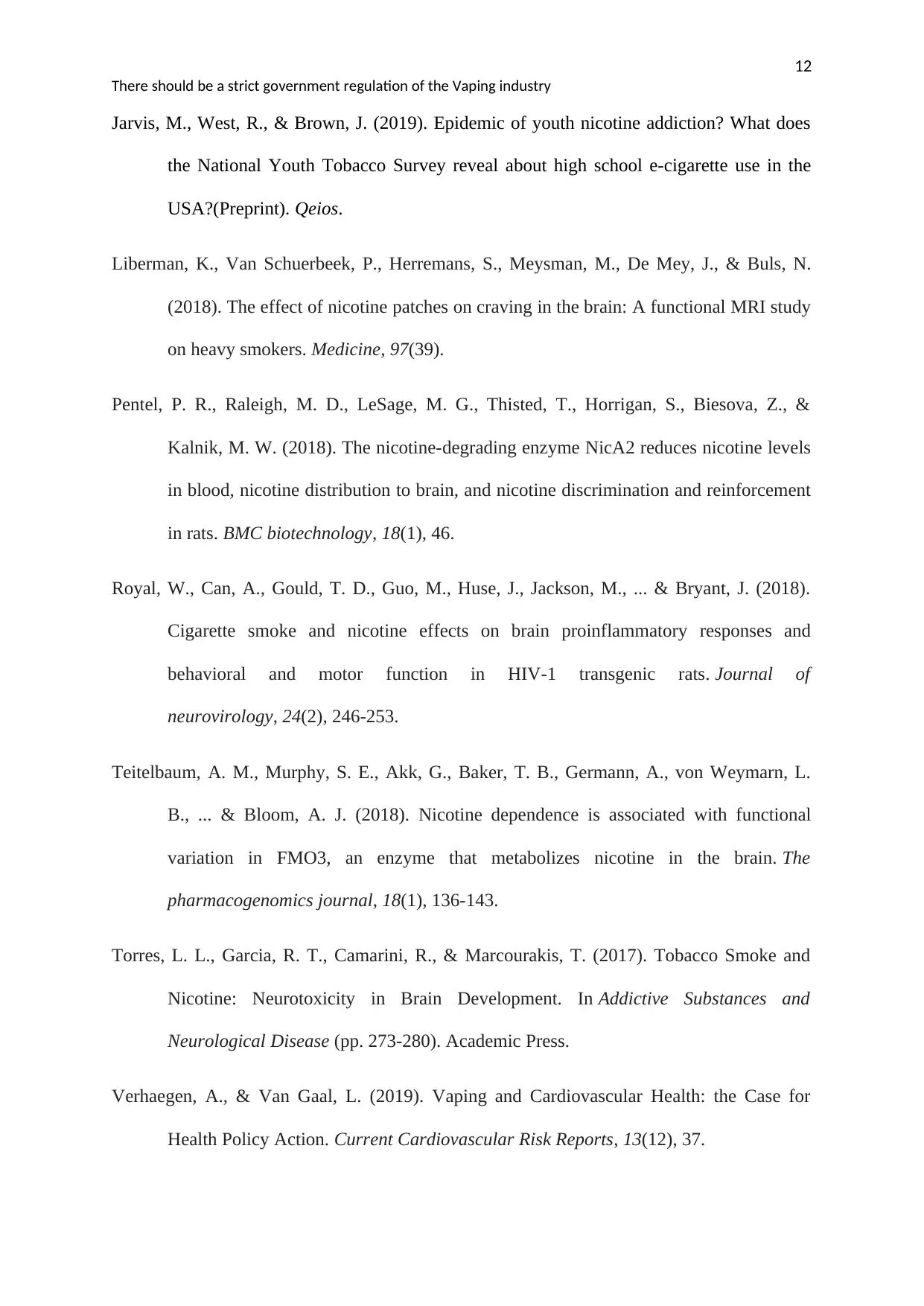
12
There should be a strict government regulation of the Vaping industry
Jarvis, M., West, R., & Brown, J. (2019). Epidemic of youth nicotine addiction? What does
the National Youth Tobacco Survey reveal about high school e-cigarette use in the
USA?(Preprint). Qeios.
Liberman, K., Van Schuerbeek, P., Herremans, S., Meysman, M., De Mey, J., & Buls, N.
(2018). The effect of nicotine patches on craving in the brain: A functional MRI study
on heavy smokers. Medicine, 97(39).
Pentel, P. R., Raleigh, M. D., LeSage, M. G., Thisted, T., Horrigan, S., Biesova, Z., &
Kalnik, M. W. (2018). The nicotine-degrading enzyme NicA2 reduces nicotine levels
in blood, nicotine distribution to brain, and nicotine discrimination and reinforcement
in rats. BMC biotechnology, 18(1), 46.
Royal, W., Can, A., Gould, T. D., Guo, M., Huse, J., Jackson, M., ... & Bryant, J. (2018).
Cigarette smoke and nicotine effects on brain proinflammatory responses and
behavioral and motor function in HIV-1 transgenic rats. Journal of
neurovirology, 24(2), 246-253.
Teitelbaum, A. M., Murphy, S. E., Akk, G., Baker, T. B., Germann, A., von Weymarn, L.
B., ... & Bloom, A. J. (2018). Nicotine dependence is associated with functional
variation in FMO3, an enzyme that metabolizes nicotine in the brain. The
pharmacogenomics journal, 18(1), 136-143.
Torres, L. L., Garcia, R. T., Camarini, R., & Marcourakis, T. (2017). Tobacco Smoke and
Nicotine: Neurotoxicity in Brain Development. In Addictive Substances and
Neurological Disease (pp. 273-280). Academic Press.
Verhaegen, A., & Van Gaal, L. (2019). Vaping and Cardiovascular Health: the Case for
Health Policy Action. Current Cardiovascular Risk Reports, 13(12), 37.
There should be a strict government regulation of the Vaping industry
Jarvis, M., West, R., & Brown, J. (2019). Epidemic of youth nicotine addiction? What does
the National Youth Tobacco Survey reveal about high school e-cigarette use in the
USA?(Preprint). Qeios.
Liberman, K., Van Schuerbeek, P., Herremans, S., Meysman, M., De Mey, J., & Buls, N.
(2018). The effect of nicotine patches on craving in the brain: A functional MRI study
on heavy smokers. Medicine, 97(39).
Pentel, P. R., Raleigh, M. D., LeSage, M. G., Thisted, T., Horrigan, S., Biesova, Z., &
Kalnik, M. W. (2018). The nicotine-degrading enzyme NicA2 reduces nicotine levels
in blood, nicotine distribution to brain, and nicotine discrimination and reinforcement
in rats. BMC biotechnology, 18(1), 46.
Royal, W., Can, A., Gould, T. D., Guo, M., Huse, J., Jackson, M., ... & Bryant, J. (2018).
Cigarette smoke and nicotine effects on brain proinflammatory responses and
behavioral and motor function in HIV-1 transgenic rats. Journal of
neurovirology, 24(2), 246-253.
Teitelbaum, A. M., Murphy, S. E., Akk, G., Baker, T. B., Germann, A., von Weymarn, L.
B., ... & Bloom, A. J. (2018). Nicotine dependence is associated with functional
variation in FMO3, an enzyme that metabolizes nicotine in the brain. The
pharmacogenomics journal, 18(1), 136-143.
Torres, L. L., Garcia, R. T., Camarini, R., & Marcourakis, T. (2017). Tobacco Smoke and
Nicotine: Neurotoxicity in Brain Development. In Addictive Substances and
Neurological Disease (pp. 273-280). Academic Press.
Verhaegen, A., & Van Gaal, L. (2019). Vaping and Cardiovascular Health: the Case for
Health Policy Action. Current Cardiovascular Risk Reports, 13(12), 37.
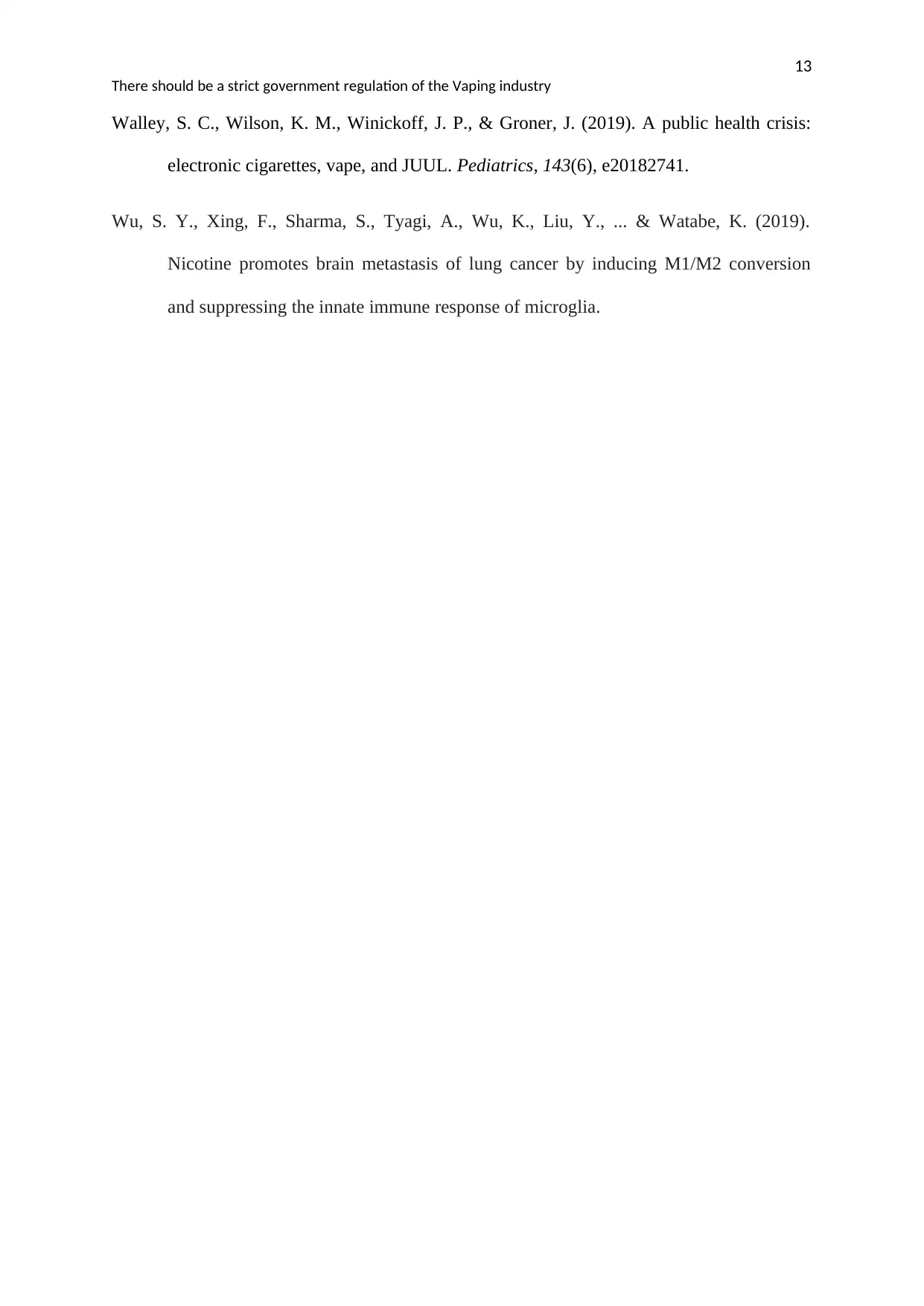
13
There should be a strict government regulation of the Vaping industry
Walley, S. C., Wilson, K. M., Winickoff, J. P., & Groner, J. (2019). A public health crisis:
electronic cigarettes, vape, and JUUL. Pediatrics, 143(6), e20182741.
Wu, S. Y., Xing, F., Sharma, S., Tyagi, A., Wu, K., Liu, Y., ... & Watabe, K. (2019).
Nicotine promotes brain metastasis of lung cancer by inducing M1/M2 conversion
and suppressing the innate immune response of microglia.
There should be a strict government regulation of the Vaping industry
Walley, S. C., Wilson, K. M., Winickoff, J. P., & Groner, J. (2019). A public health crisis:
electronic cigarettes, vape, and JUUL. Pediatrics, 143(6), e20182741.
Wu, S. Y., Xing, F., Sharma, S., Tyagi, A., Wu, K., Liu, Y., ... & Watabe, K. (2019).
Nicotine promotes brain metastasis of lung cancer by inducing M1/M2 conversion
and suppressing the innate immune response of microglia.
1 out of 13
Related Documents
Your All-in-One AI-Powered Toolkit for Academic Success.
+13062052269
info@desklib.com
Available 24*7 on WhatsApp / Email
![[object Object]](/_next/static/media/star-bottom.7253800d.svg)
Unlock your academic potential
© 2024 | Zucol Services PVT LTD | All rights reserved.




